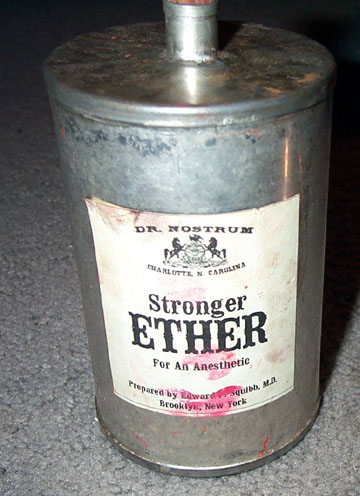"Stronger Ether"
from
Dr Nostrum


DIETHYL ETHER: H5C2-O-C2H5
Ether is highly flammmable. Its vapour is heavier than air, so ether fumes may travel along the ground, creating the conditions for distant ignition. Under the influence of light and air, ether can form explosive peroxides. It attacks plastic and rubber. Ether reacts explosively with halogens, sulphur compounds and oxidants. Thus it poses a serious fire risk.
Ether has an extremely low blood/gas partition coefficient. Thus the induction of anaesthesia is slow when ether is used as the sole anaesthetising agent prior to surgery. Anaesthesiologists now rarely use this agent in America and Europe; but its cheapness and simplicity of administration ensure its survival in third world countries.
Of the three staples of early anaesthetic practice - nitrous oxide, chloroform and ether - only nitrous oxide remains in regular use in the advanced world.
Dr Henry Bigelow, author of Insensibility during surgical operations produced by inhalation (1846), reports that from his own experience the effects of inhaling sub-anaesthetic doses of pure ether were almost as exhilarating as nitrous oxide "or of the Egyptian haschish" [hashish]. Dr Bigelow sought to reassure his readers that ether was benign. He recalls how there was "scarcely a school or community in our country where the boys and girls have not inhaled ether, to produce gayety."
- Molecular mass: 74.1
- Boiling point: 35°C
- Melting point: -116°C
- Relative density (water = 1): 0.7
- Solubility in water, g/100 ml at 20°C: 6.9
- Vapour pressure, kPa at 20°C: 58.6
- Relative vapour density (air = 1): 2.6
- Relative density of the vapour/air-mixture at 20°C (air = 1): 1.9
- Flash point: -45°C c.c.
- Auto-ignition temperature: 160-180°C
- Explosive limits, vol% in air: 1.7-48
- Octanol/water partition coefficient as log Pow: 0.89